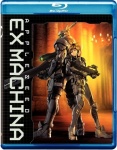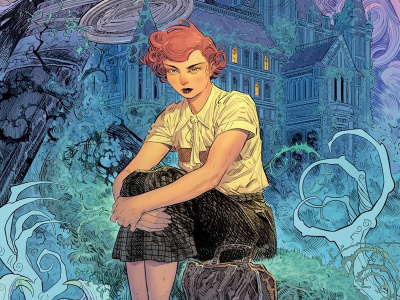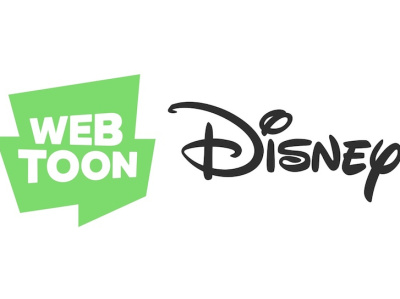
Joseph Chou worked at Warners on the Animatrix, which was one of the top selling anime DVDs this side of the first Pokemon movie in the North American market, before forming his own Axis Productions where Chou has played a major role in the production and marketing of Appleseed: Ex Machina. Chou took some time to discuss his involvement with the project as well as the future of theatrical and home video entertainment. In Part One, he discusses the successful launch of the Ex Machina DVD and the contributions of producer John Woo and director Shinji Aramaki.
Tell us a little bit about your background and how you became involved in Appleseed Ex Machina.
Yes, well I'm a producer of Appleseed Ex Machina. As for my background I started at Warner Bros. with planning and development on the Animatrix. I worked on the business side on it, and I was also working on something called the "Anime Business Committee" through which Warner Bros. was trying to find a strategy to become involved in anime, and I worked on that for awhile. Then I decided to come out and pursue my own productions and my first project is this (Appleseed Ex Machina). The last five years I have been focusing on anime production and films based on anime and manga.
Well the Animatrix certainly was a big hit -- at least in the American market, wasn't it?
Yeah, I think that did about 2.5 million units worldwide, so I think it's done really well.
How is Appleseed Ex Machina doing on DVD -- it's been out about ten days now hasn't it?
It's been out over a week. So far it's been selling out pretty much whenever it hits the stands in Best Buy and Wal-Mart, and all the major chains that we are hitting. By now I think it's sold through 100,000 units. I hope this continues -- with John Woo producing we are trying to reach out to a larger market -- obviously anime fans are the core market for this title, but we also wanted to reach out to a wider audience. This is the sort of thing that I think in the future we can do to serve the market outside of
We've heard that almost 30% of the sales of Ex Machina so far have been in the Blu-ray format, how do you explain that?
I'm a little surprised, but at the same time I realize that the fans came out in droves and supported the 2-disc Special Edition and the Blu-ray really well in spite of the higher price points. One thing I think it shows is that anime fans are really on the cutting edge of technology as they were when DVD was first introduced, and secondly I think a lot of them are also PlayStation 3 owners -- and I also think that Ex Machina has a real appeal to gamers.
The John Woo name should also help you interest the action film audience?
That was our hope. John Woo is one of those names that actually carries some meaning; we hope to reach out to people who really like his films, like his style -- I'm certainly one of them, I grew up watching his Hong Kong stuff when I was in Korea -- and I really hope that John Woo fans or just action fans will find this interesting.
Can you describe the sort of input that John Woo had on this Appleseed project?
Actually we tried to cover this question in the special features that are included on the DVD. He was involved from the story stage, he had input on the story and also on the action elements. We had a few meetings with Shinji Aramaki, the director, and John Woo together. Woo gave us a lot of input; it was a lot of creative advice. But I was surprised and very impressed by his suggestions for us to think about emotional moments that would actually make the action scenes matter. He knew how to touch the emotional core by doing certain things that really got to the hearts of the characters and what they care about. That's when you start to realize that the John Woo style is not all about the flash and slo-mo action sequences, there's really something deeper than that. It's something that we were really impressed with and hopefully something that is reflected in the film.
You can see in the movie how Deunan has bonded with Briareos and how she develops feelings for Tereus.
Well it's easy to just do straight action and cool sequences, but he really knew how to push those emotional buttons, and kind of have us realize what would cause us to care more about these characters. And the themes of the triangle, and the test of friendship and the test of love, these are some of the themes that John Woo explores in his movies, and I think that was also part of the reason that he found the project attractive.
There were a lot of "John Woo" touches, the balletic use of slow motion, the spent cartridges cascading to the floor, the slo-mo bullet shot, and they seemed to fit right in place in this movie.
Thank you -- it's interesting in the first scene where you see the dove flying and the cathedral and rescue of the hostages -- those were actually done without John's input, but as a sort of homage to him. That was done as a sort of sales promo and when it was first shown to John, the filmmakers were kind of afraid that he might get a little upset, but he was a great sport about it, and he turned around and came up with some ways to improve those scenes. So when you see the opening it's actually a combination of the team's idea of what John's action style would be like in this medium and then he also came in and tweaked it to make it better. I thought it was a pretty interesting collaboration.
The movie also has lots of mecha action for anime fans, and some great mecha designs, which testify to Aramaki's expertise.
Obviously Aramaki is well known as the designer of the mecha in Robotech, Mospeada, Bubblegum Crisis -- a lot of the classic mecha designs. He's known for that and I think it shows through how much he cares about the designs of the mecha and the weapons -- and this film does showcase his ability as a designer as well as a director and we hope to do more of this actually.
For Part 2, click here.







